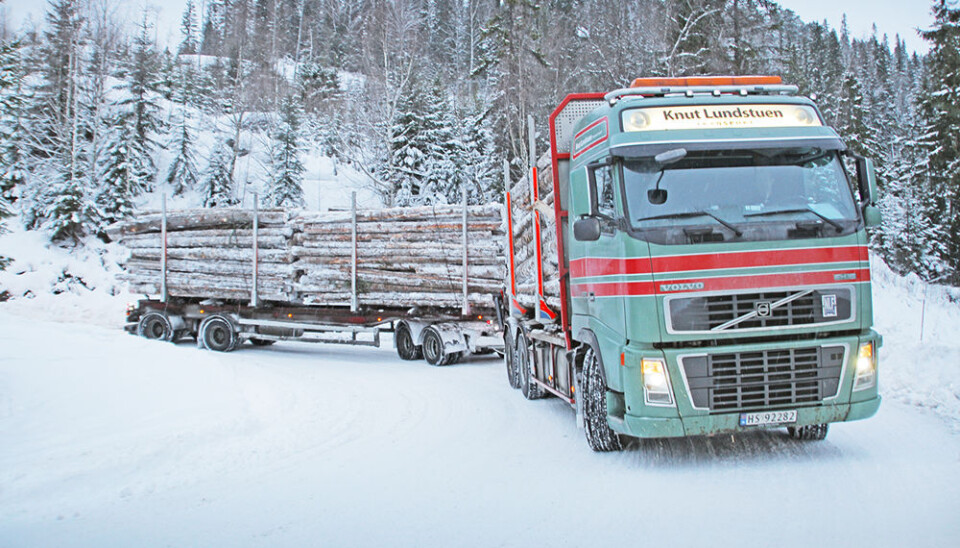An article from The Norwegian Forest and Landscape Institute

Larger logging trucks give less CO2 emissions
The forest production chain’s emissions of greenhouse gases are very low. Most of these are CO2 emissions from on-road timber transport.
Denne artikkelen er over ti år gammel og kan inneholde utdatert informasjon.
One half of forestry’s total CO2 emissions come from logging trucks. A new study shows that logging trucks with a gross weight of 48 tons emit 25 percent more CO2 per transported cubic metre of timber than trucks that weigh 60 tons.
Low emissions from logging operations
The total emissions of greenhouse gasses from all timber harvesting operations in Norway in 2010 amounted to 150,000 tons of CO2-equivalents.
In contrast, all forests in Norway sequester about 25-30 million tons CO2. This figure represents about 60 percent of the total greenhouse gass emissions in Norway.
Forests play a major role in the global carbon cycle. Through photosynthesis, trees absorb CO2 and fix the carbon in stems, branches and roots. Although increased use of forest-based bioenergy reduces our dependency on fossil fuels, the planting, thinning, felling and transport of timber requires energy and thus leads to gass emissions.
Calculations made by the Norwegian Forest and Landscape Institute showed that forestry emits 18 kilograms CO2 per cubic metre timber felled and transported to the wood processing industry in 2010. These emissions represent about 2.4 percent of the total amount of CO2 sequestered by one cubic metre standing timber.
Life cycle assessments
As part of the KlimaTre project, the Norwegian Forest and Landscape Institute has tried to quantify the emissions of greenhouse gasses linked to the entire life cycle of a tree, from planting to delivery at the sawmill or wood processing industry (cradle-to-gate inventory).
The presented results were obtained by using a life cycle assessment tool, which analyses the energy consumed throughout the product’s lifetime. This enables us to determine more accurately the energy consumed, and thus the amount of greenhouse gasses emitted, in the various parts of the forest production chain.
Such life cycle assessments are like a huge puzzle. The big picture of forestry’s total energy consumption and green house emissions is obtained by putting all the pieces of the entire process together: from planting and harvesting to transport to the processing site.
Less emissions from larger trucks, trains and ships
The comparison of different sizes of logging trucks was an important part of the life cycle analysis of the forest sector’s CO2 emissions. Results showed that logging trucks with a gross weight of 48 tons emit 25 percent more CO2 per transported cubic metres of timber than 60 ton trucks.
Our comparison of road and rail transport, which was based on a capacity of 1000 cubic metre timber per train and a distribution of the haulage between diesel and electric trains of 12 and 88 percent, respectively, showed that 48 ton trucks emit six times more CO2 per cubic metre timber hauled than transport by rail.
In 2010, rail transport accounted for 34 percent of pulpwood, which is wood used for paper production, and only 1.5 percent of saw timber haulage.
The cost-efficiency of rail transport increases with increasing distance to the wood-processing plants. Our comparison of road and sea transport was based on the use of a medium-sized cargo vessel with a capacity of 5000 cubic metre of timber, which is equivalent to more than 100 logging trucks. Results showed that the ship’s CO2 emissions per cubic metre transported timber are 75 percent lower than those of a 48 ton logging truck, assuming a fuel consumption of 22 L/100 km.
The potential for increasing the volume of timber transport by sea is to a certain extent limited by the lack of port facilities and infrastructure along the Norwegian coast.
































